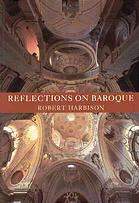
Reflections on Baroque PDF
Preview Reflections on Baroque
REFLECTIONS ON BAROQUE , REFLECTIONS ON BAROQUE ROBERT HARBISON REAKTION BOOKS ForCraig andSherrill ReaktionBooksLtd 79FarringdonRoad LondonECIM 3JU,UK wwwreaktionbooks.co.uk Firstpublished2000 Copyright©RobertHarbison2000 Allrightsreserved Nopartofthispublicationmaybereproduced,storedina retrievalsystem,ortransmitted,inanyformorbyanymeans, electronic,mechanical,photocopying,recordingorotherwise, withoutthepriorpermissionofthepublishers. BritishLibraryCataloguinginPublicationData Harbison,Robert ReflectionsonBaroque I.Arts,Baroque I.title 700.9032 PrintedandboundinGreatBritainby BiddIesLimited,GuildfordandKing'sLynn CONTENTS FOREWORD vii THE CASE FOR DISRUPTION Bernini,Borromini,MattiaPreti,Milton,StIgnatius,Monteverdi, FischervonErlach,CostanzoMichela,Juvarra,thoroughfares,staircases, SacredMounts,StTeresa,plaguecolumns,ceilings(Pozzo,Maulbertsch, Tiepolo),Marvell,Crashaw II TORMENTED VISION 33 Maulbertsch,.Handel,Rubens,SacredMounts,the sketch, Clerisseau, Soane,Sterne,Vittone,Borromini,convents,saints, theSacredHeart,Messerschmidt,the cultofsensibility III THE VIEW FROM ABOVE 60 Wren, Ragusa,Palermo,Rubens, Milton,Dryden,Vanbrugh, Jesuitexpansion,Defoe,Queretaro,Noto,BlandfordForum, Turin,Versailles,Schonbrunn,Bucharest,Pope IV THE END OF HEROISM 78 Mozartand opera(1'domeneo, Cosifantutte,Lafintagiardiniera),Asambrothers (Rohr,Weltenburg,Freising),Serpotta,Watteau V THE WORLD AS SCENERY 102 Congreve,Pope,the Bibienafamily,Piranesi, Soane,the Gothic novel,Veniceasscenery,Canaletto,Guardi,Longhena,Vanbrugh VI BAROQUE NATURE 127 IsolaBella,GiardinoBuonacorsi,Versailles,Nymphenburg,Amalienburg, Veitshochheim,graveyards,Englishlandscapegardens,DieWies, Vierzehnheiligen,new and exoticspecies,scientificdrawings,encyclopedias, theAcademyofLynxes,Rameau,Waldsassen,Pianta,Hogarth, Messerschmidt,Handel,Goya CONTENTS VII COLONIAL BAROQUE 164 Ocotlan,tilefacades, backwaters,SagrarioMexicoCity,Hindutemples, GoanBaroque,StFrancisXavier,BolivianJesuitsacredopera,San!'A/essio, SantaRosaliaorThe WoundedDove,Stradella'soratorioerotica,Tepotzotlan, Salamanca,Queretaro VIII NEO AND PSEUDO BAROQUE 192 RussianBaroque,TurkishBaroque,PersianRococo,EdwardianBaroque, Linderhof,porcelainknick-knacks,'50SAmericancars,JeffKoons,Richard Strauss,Beardsley,Guimard,theNationalTrust,BellottoandWarsa~ Baroquepearls,JapaneseBaroque,GothicBaroque,ChineseBaroque, HellenisticBaroque,W6lfflin,Deleuze IX BAROQUE IN THE TWENTIETH CENTURY 222 CzechCubists,Santini,T.S.Eliot,Gehry,CoopHimmelblau, RussianConstructivists,Scharoun,LudwigLeo,Miralles NOTES 241 ACKNOWLEDGEMENTS 253 PHOTOGRAPHIC ACKNOWLEDGEMENTS 254 INDEX 255 vi FOREWORD THE BAROQUE can beviewed asanepisodein the historyof art, or of religion,orofabsolutistpoliticsorofconsciousnessmoregenerally.In art it begins in Rome with work which owes a lot to Michelangelo's impatientdeformations of Renaissance prototypes and quickly pro gresses to something more extrovert and untrammelled on scales seldom seen before. In religion it is tied to Counter-Reformation reassertions of Catholic orthodoxy against Protestantincursions, but shows individualisttraces suspiciously similarto Protestantism,atleast tountrainedeyes.Inpoliticsitcorrespondsto theincreasingcentraliza tion of power in the monarch and the vigorous ritual displays which accompanyit.To define the significanceoftheBaroquefor conscious ness generally is more difficult. What mayhave begun asintimidating declamation can become acelebrationof turbulence for its own sake, the equivalentin art ofwhitewaterrafting, and such exuberancedoes notalwaysremainwithinthe boundsofart. Itisamodewhichbegins in Italyand eventually encompassesallof Catholic Europe, with distinct local forms in Spain and Portugal, Austria, southernGermanyand Bohemia,Sicily,Piedmontand France. Northern Protestant variants are more problematic - debates still continue over whether there is an English Baroque at all - but it is safe to say that no European art or thought of the seventeenth and eighteenthcenturyremainedimmuneto the influenceof the Baroque, which was also carried by Spanish and Portuguese colonizers to the Americasand India. In some places the mode lasted ahundred and fiftyyears from the early seventeenth to the late eighteenth century, until replaced by sternerclassicalrevivals.Therearemanytransitionalfiguresand monu ments. The Bavarian architect Balthasar Neumann was either lucky or unluckydependingonyour preferences:hecamelateenoughforhis Baroque spaces in several instances to be fitted outwith cooler neo classicaltrimmings. Amodewhichprevailsoversuchawideterritoryforsuchanextended vii REFLECTIONS ON BAROQUE period will accommodate many variations, but the Baroque is con sistently remarkable for the value it places on subjective response, aiming to stir the spectator's emotions actively. The consequences of this approach are profound and work against the tendency of some Baroqueproductstointimidatethe undefendedindividual.Whatbegins as an authoritarian mode comes in course of time to accommodate desires for human-scaled comfort and relaxed subject matter. So the gargantuanboasts ofBaroqueevolvetowards thegentlerRococo,some times without a clear break. In Bavaria particularly, large architectural carcasses are embellishedwithacharmingfiligreeof plasterornament whichturnswholechurchinteriorsintogroves and bowers. Rococo takes a considerable share of this book because metamor phosis is one of the fundamental processes of the Baroque and the transition to Rococo is the most important upheaval within it. With practice anyone willlearn to tell when Baroque has become Rococo. Everythingislighter,moresinuous,moreplayfulandthoroughlysecular. Shepherds, pastel colours, brief forms and small spaces - exquisite rather than grand effects characterize Rococo, which one would not expectto findbeforethe seconddecadeofthe eighteenthcenturyeven in France, its land of origin. This tendency spreads east more readily thanitdoes south:ItalianRococoisararity. This book applies a few Baroque principles in treating its subject. The first is a mixing of genres. In the seventeenth century borders between genres cease to be strictly observed and become blurred in forms likeopera, which combinesarchitectureand perishablesculpture type effectswithmusic and literarytexts. Themostelaborateinteriors of the period also aim at phantasmagoric mergings of architecture, paintingandsculpture,deliberatelyconfusingthebordersbetweenthem, thegoal asingleoverpoweringeffect.Soitseemedlessappropriatethan ever to segregate architecture from painting, epic poetry, gardens or operain this book. Instead, I have tried to showhow similarintentions are differentlyrealized in differentmediums, believingthat such com parisonssharpenourperceptionofbothhalves. Moredebatableperhapsisthe book'shandlingofchronology.While I accept that examples should be presented in chronological order unless there is a compelling reason to violate it, there are many such reasonsinthe fieldbeforeus.Timedoes notrunforwardsmoothlyand uniformly in all human activities across the whole world. Music is generallyagreedtobeoutofsyncwithmostotherartsinthe eighteenth viii FOREWORD century. Bach doesn'tseem Rococo, norMozartRomantic,atleast not primarily.Geographicaldiscontinuitiesarealsolegion:SicilianBaroque lagsperhaps twenty yearsbehindRoman, for example. Butwe cannot leaveit at that: in some senses the two are not comparable and what ismostspecialin Sicilianforms cannotbe translated,boundup asitis with the isolationand peculiar pastoftheisland. Chronologyisonlyoneorderingsystem,and thereareothers,mainly thematic, which seem more suitable to the present subject. Likewise geography- thereisno attempthere to giveacompletepictureof any part of the territory. A few omissions I regret and cannot entirely accountfor,Pragueand Guariniinparticular,bothofwhich, the place and the designer,werecentraltomyideaoftheBaroque,butsomehow foundno placehere. Otherwise,thegeographicalrangeisaswideasmy experience allows and the examples are chosen because they are the most powerful of their kind, the most striking works of their author who isthemostcompellingworkerinhismediuminhistimeandplace. Sometimes I have chosenlesswell-knownworks which deservewider circulation.OftenIhavebeendrawntooddities,liketheSicilianstuccoist Serpotta,theSacredMountsofPiedmontortheDutchtulipcraze.Part of the justification for this emphasis is that the Baroque (none of the threeisexactlystandardBaroqueof course) tends to extremes, having littleinterestinquiet,well-behavedworks. I realize, though, that I am pushing even further into odd corners, towards the edge where artistic production becomes simply freakish. I heard the other dayof someonelivingin one roomin Chicagowho wrote the longest fiction yet known (called 'In the Realm of the Unreal') and apparently showed it to no one. I do not know how his name is spelled, and I suppose it is revealing that I find him such a keyinstance.Myversionof the Baroqueisthatof an unreconstructed individualistwho thinks crucial stages oflarge historicalprocesses are sometimesillustratedbestbyexceptions. Thisbookthereforecontains a high quotient of the extraordinary, the unrepeatable, the one-off, whichisnotthere for itself alone butbecauseitilluminates muchelse, perhapsjustbysteppingoutsideit. Itwillcome as no surprise that the bookis organized thematically rather than chronologically or geographically, until its latter parts, where it departs from the central territory to trace transmutations of Baroquematerial farafieldinbothtime and space. Thefirstchapterintroducesthe mostdistinctive feature ofBaroque ix
